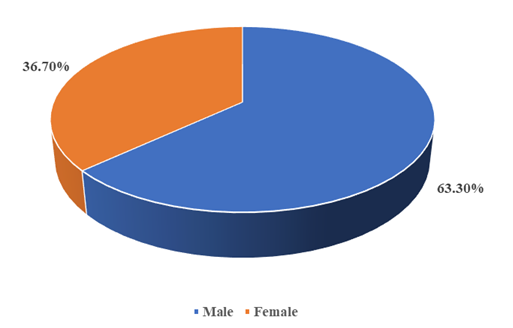The Prevalence, Diagnosis, and Management of Voice Disorders in a Single Center Study
Abstract
Background: Vocal disorders are challenging medical conditions to research nationally. Vocal disorders are a diverse collection of complaints based on symptoms, unlike other system-based illnesses that have well-defined pathologic, laboratory, or objective diagnostic criteria. No specialized national database or agency is in place to gather information on patients with voice problems. Large-scale epidemiologic studies that examine the prevalence, contributing causes, and available treatments for voice disorders are therefore uncommon. Objectives: This study was done to evaluate the prevalence, diagnosis, and management of voice disorders in a single center study. Methods: The cross-sectional study was conducted in the Department of ENT, Prime Medical College Rangpur from June 2021 to May 2022. A total of 60 subjects of both sexes were included in the study. Data were collected by face-to-face interview and analyzed by appropriate computer based programmed software Statistical Package for the Social Sciences (SPSS), version 22. Results: In this study, most of the patient 16 (26.6%) lies between 41 years to 50 years and about 38 (63.30%) patients were female and 22 (36.70%) patients were male. About 19 (31.7%) patients had acute condition and 24 (40.0%) had chronic condition. Most of the patients 73.3% had asthma, about 70% patients had respiratory allergy. About 38 (63.3%) had smoking habit and 22 (36.7%) patients were non-smoker. Most of the patients 37 (78.3%) had no family history of voice disorder and 13 (21.6%) had the family history. Conclusion: According to the current study, a significant proportion of VC patients' diagnostic and treatment programs nationwide are in accordance with established guidelines. To improve care for patients with vocal issues, doctors of various specialties should be aware of these recommendations.
Downloads
References
World Health Organization. (2022). Ageing and health. https:// www.who.int/news-room/fact-sheets/detail/ageing-and-health
Roy N, Merrill RM, Gray SD, Smith EM. Voice disorders in the general population: prevalence, risk factors, and occupational impact. Laryngoscope 2005; 115:1988–1995.
Simberg S, LaineA, SalaE, et al. Prevalence of voice disorders among future teachers. J Voice. 2000; 14:231–235.
JonesK, SigmonJ, HockL, et al. Prevalence and risk factors for voice problems among telemarketers. Arch Otolaryngol Head Neck Surg. 2002; 128:571–577
LybergA_hlanderV, RydellR, L€ofqvistA. Speaker's comfort in teaching environments: voice problems in Swedish teaching staff. J Voice. 2011; 25:430–440.
Fellman D, Simberg S. Prevalence, and risk factors for voice problems among soccer coaches. J Voice.2017;1: e9–e121.
Smith E, Gray SD, Dove H, et al. Frequency and effects of teachers' voice problems. J Voice.1997;11:81–87.
Russell A, Oates J, Greenwood K. Prevalence of self-reported voice problems in the general population in South Australia. Adv Speech Lang Pathol. 2005; 7:24–30.
Best SR, Fakhry C. The prevalence, diagnosis, and management of voicedisorders in a National Ambulatory Medical Care Survey (NAMCS) cohort. Laryngoscope. 2011; 121:150–157.
Roy N, Merrill RM, Thibeault S, et al. Voice disorders in teachers and the general population: effects on work performance, attendance, and future career choices. J Speech Lang Hear Res. 2004; 47:542–551.
Cohen S, Kim J, Roy N, et al. Prevalence and causes of dysphonia in a large treatment-seeking population. Laryngoscope. 2012; 122:343–348.
Roy N, Tanner K, Merrill RM, et al. Descriptive epidemiology of voice disorders in rheumatoid arthritis: prevalence, risk factors, and quality of life burden. J Voice. 2016; 30:74–87.
Simon R. and Fakhry C. The Prevalence, Diagnosis, and Management of Voice Disorders in a National Ambulatory Medical Care Survey (NAMCS) Cohort. The Laryngoscope. 2011; 121:150–157
Ahlander VL. Rydell R. Fredlund P. et al. Prevalence of Voice Disorders in the General Population, Based on the Stockholm Public Health Cohort Journal of Voice. 1997. pp.1_6 0892



























